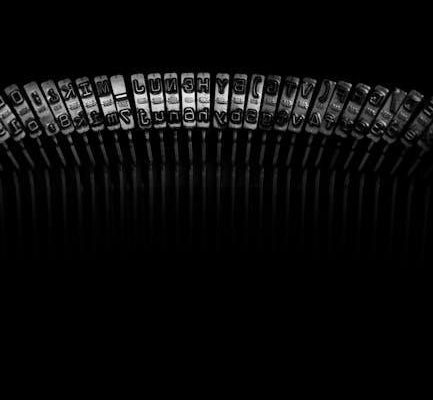A manual machine press is a mechanical device used to shape‚ form‚ or assemble materials by applying controlled force. It offers precision and reliability in various industries.
What is a Manual Machine Press?
A manual machine press is a mechanical device operated by hand or lever to apply force for shaping‚ forming‚ or assembling materials. It is widely used in metalworking‚ plastic processing‚ and woodworking. The press consists of a frame‚ a ram‚ and a drive system‚ enabling precise control over the applied force. Manual presses are known for their simplicity‚ cost-effectiveness‚ and ease of use‚ making them ideal for small-scale operations or precise tasks requiring human oversight. They are versatile tools in various industrial and craft applications.
Types of Manual Machine Presses
Manual machine presses are categorized into several types based on design and functionality. The C-frame press is compact and suitable for small-scale operations. The H-frame press offers greater rigidity and is used for heavier tasks. Arbor presses are versatile‚ often used in metalworking for precise hole punching. Bench presses are portable and ideal for workshops. Each type is tailored to specific applications‚ ensuring efficiency and accuracy in various industrial and craft settings. Understanding these types helps in selecting the right tool for the job.
Advantages of Using a Manual Machine Press
Manual machine presses provide cost-effectiveness‚ requiring minimal investment and maintenance. They are user-friendly‚ with straightforward operation that reduces training needs. Their portability and space-saving design make them ideal for small workshops. Manual presses also ensure precise control‚ enabling accurate results. Additionally‚ they operate quietly and produce low vibrations‚ enhancing workplace safety. These advantages make manual presses a preferred choice for various industries‚ offering reliability and efficiency without the complexity of automated systems. Their simplicity ensures consistent performance across diverse applications.
Applications of Manual Machine Presses
Manual machine presses are versatile tools utilized across various industries. They are widely used in metalworking for cutting‚ shaping‚ and forming metal sheets. In plastic and composite processing‚ they assist in molding and shaping materials. Woodworking applications include cutting and shaping wood accurately. Additionally‚ these presses are employed in specialized industrial tasks‚ such as custom assembly and prototyping. Their precision and reliability make them ideal for both small-scale and precise manufacturing needs‚ ensuring consistent results across diverse applications.
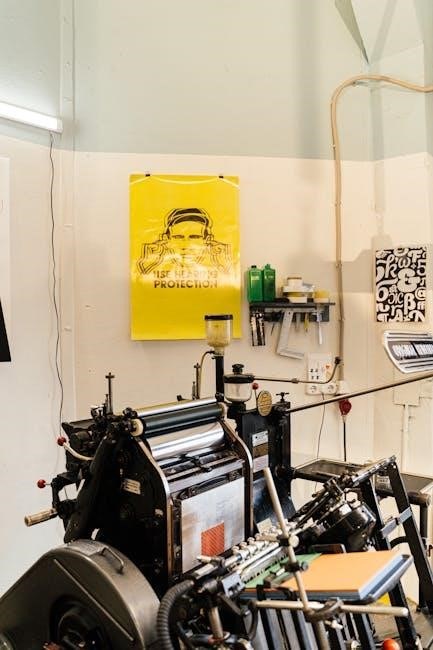
Design and Construction of Manual Machine Press
Manual machine presses are built with sturdy frames‚ precise rams‚ and reliable drive systems. Durable materials ensure longevity‚ while safety features enhance operational security and control.
Key Components of a Manual Machine Press
- Frame: The sturdy base that supports the press‚ ensuring stability during operation.
- Ram: The moving part that applies force to the workpiece‚ guided by columns or slides.
- Drive System: Manual or mechanical mechanisms‚ like hand wheels or levers‚ that power the ram.
- Safety Features: Guards‚ emergency stops‚ and interlocks to protect operators and prevent accidents.
Materials Used in Manual Machine Press Construction
Manual machine presses are constructed from high-strength materials to ensure durability and precision. Steel alloys are commonly used for frames and moving parts due to their strength and rigidity. Cast iron is often employed for frames and beds because of its excellent vibration-dampening properties. Bronze and steel are used for bearings and wear surfaces to reduce friction. Tool steel is utilized for dies and punch components to withstand high pressures. These materials ensure the press operates effectively under heavy loads and maintains accuracy over time.
Frame and Ram Design Considerations
The frame of a manual machine press is designed to withstand heavy forces while maintaining structural integrity. A rigid‚ box-like structure is often used to minimize deflection. The ram‚ which delivers the pressing force‚ is typically guided by bushings or rollers to ensure smooth‚ precise movement. Proper alignment and clearance between the frame and ram are critical to prevent binding. Additionally‚ stress analysis and material selection are crucial to ensure long-term durability and performance under repetitive loading conditions.
Drive Systems in Manual Machine Presses
Manual machine presses utilize drive systems to transmit power for operation. Common systems include gears‚ levers‚ and crank mechanisms. These components are designed to amplify force efficiently while maintaining control. Gear-driven systems provide precise torque for heavy-duty applications‚ while lever systems offer simplicity and ease of use. Proper lubrication and alignment are essential to ensure smooth operation and longevity. Regular maintenance of moving parts helps prevent wear and tear‚ ensuring consistent performance over time. Durable materials‚ such as steel and bronze‚ are often used in these systems for reliability.
Safety Features in Manual Machine Press Design
Manual machine presses are equipped with essential safety features to protect operators and ensure safe operation. Key components include emergency stop mechanisms‚ protective guards‚ and interlocks to prevent unintended movement. These designs minimize the risk of accidents by restricting access to hazardous areas. Additionally‚ overload protection systems are integrated to prevent damage to the machine and injury to the user. Proper training and adherence to safety protocols are emphasized to maintain a secure working environment.

Operation and Maintenance of Manual Machine Press
Operating a manual machine press requires following proper procedures‚ regular lubrication of moving parts‚ and periodic inspection of components to ensure smooth and safe functionality.
Step-by-Step Guide to Operating a Manual Machine Press
- Ensure the machine is properly assembled and lubricated before use.
- Position the workpiece accurately on the press bed‚ aligning it with the die.
- Slowly apply manual force to the handle‚ maintaining control throughout the stroke.
- Release the handle to return the ram to its starting position.
- Inspect the workpiece for accuracy and repeat if necessary.
- Regularly check and maintain moving parts to ensure smooth operation.

Always follow safety guidelines and manufacturer instructions for optimal performance.
Regular Maintenance Requirements
Regular maintenance is crucial for optimal performance and longevity of a manual machine press. Lubricate moving parts periodically to reduce friction and wear. Inspect the press frame‚ ram‚ and drive system for alignment and damage. Clean the press bed and dies to prevent debris buildup. Check for loose bolts and tighten them as needed. Replace worn or damaged components promptly to avoid downtime. Schedule professional servicing annually to ensure precision and safety. Proper upkeep prevents malfunctions and extends the machine’s lifespan.
Troubleshooting Common Issues
Common issues with manual machine presses include misalignment‚ jamming‚ or inconsistent force application. Check for proper die alignment and ensure the workpiece is securely positioned. Clear debris or obstructions that may cause jams. Lubricate moving parts if sticking occurs. Adjust the press frame or ram if misalignment is detected. Inspect for worn or damaged components and replace them promptly. Regularly check hydraulic or mechanical systems for leaks or malfunction. Addressing these issues promptly ensures smooth operation and prevents costly downtime or damage to the machine or workpieces.

Accessories and Attachments for Manual Machine Press
Manual machine presses can be enhanced with various accessories‚ such as tooling dies‚ alignment guides‚ and quick-change systems‚ to improve functionality and customize operations for specific tasks.
Types of Tooling and Dies
Manual machine presses utilize various types of tooling and dies to shape and form materials. Cutting dies remove material‚ while forming dies shape it without removal. Punching and bending dies are specialized for specific tasks. Materials like steel and carbide are commonly used for durability. Custom-made dies cater to unique applications‚ ensuring precision and efficiency in metalworking‚ plastics‚ and woodworking. Proper selection of tooling enhances productivity and ensures high-quality results across industries.
Alignment and Setup Tools
Alignment and setup tools are essential for ensuring precision in manual machine press operations. These tools help position dies and workpieces accurately‚ minimizing errors and improving efficiency. Gauge blocks‚ dial indicators‚ and alignment jigs are commonly used to achieve precise setups. Laser alignment tools offer advanced precision for complex tasks. Proper use of these tools ensures consistent results and reduces wear on machinery. They are indispensable in various industrial applications‚ including metalworking‚ plastics‚ and woodworking‚ where accurate alignment is critical for successful production. Regular calibration of these tools is necessary to maintain reliability and performance.
Quick-Change Systems for Efficiency
Quick-change systems are designed to enhance productivity by enabling rapid tooling and die swaps in manual machine presses. These systems minimize downtime‚ allowing operators to switch between tasks efficiently. Key features include modular components‚ easy-lock mechanisms‚ and precision alignment guides. They are particularly beneficial in high-volume production environments where frequent tool changes are necessary. By streamlining setup processes‚ quick-change systems reduce operational delays and increase overall manufacturing efficiency‚ making them a valuable addition to modern manual machine presses.

Applications of Manual Machine Press
Manual machine presses are versatile tools used in metal fabrication‚ plastic molding‚ woodworking‚ and specialized industrial tasks‚ offering precision and reliability for shaping and assembling materials efficiently.
Metalworking and Fabrication
In metalworking‚ manual machine presses are essential for shaping and forming metal components. They are used for punching holes‚ bending sheets‚ and assembling parts with high precision. The controlled force applied by these presses ensures consistent results‚ making them ideal for fabricating custom metal pieces. Additionally‚ their compact design allows for use in small workshops‚ enabling craftsmen to produce intricate designs efficiently. This versatility makes manual presses a cornerstone in both industrial and artisanal metal fabrication processes.
Plastic and Composite Processing
Manual machine presses play a crucial role in plastic and composite processing‚ enabling precise molding and shaping of materials. They are often used for thermoforming‚ where heat and pressure are applied to form plastic sheets into desired shapes. The controlled force ensures even distribution‚ reducing material waste and improving product quality. Additionally‚ these presses are utilized for bonding composites‚ ensuring strong and durable joints. Their versatility and accuracy make them indispensable in producing lightweight‚ high-performance components for various industries.
Woodworking and Carpentry
In woodworking and carpentry‚ manual machine presses are essential for tasks like laminating‚ veneering‚ and assembling wooden components. They provide the necessary pressure to ensure strong adhesive bonds and precise alignment. The controlled force helps in preventing warping or splitting of wood‚ making the process efficient and reliable. These presses are also used for fitting joints and pressing dowels‚ contributing to the creation of durable and visually appealing woodwork. Their versatility and ease of use make them a valuable tool for both professionals and hobbyists.
Specialized Industrial Applications
Manual machine presses are widely used in specialized industrial applications where precise control and repetitive tasks are essential. In aerospace‚ they are used for shaping lightweight composites. In the medical industry‚ they assist in assembling delicate components under sterile conditions. For electronics manufacturing‚ they handle small-scale precision pressing of connectors and contacts. Additionally‚ they are employed in custom fabrication shops for crafting unique parts or prototypes. Their versatility and reliability make them indispensable in these niche industrial sectors‚ ensuring high-quality outcomes with minimal operational complexity.
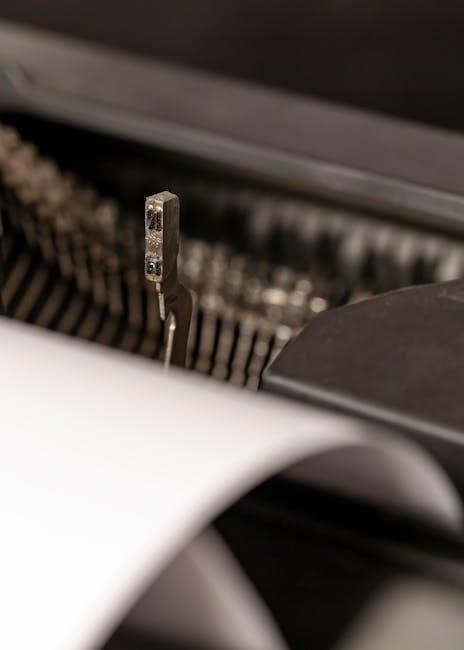
Safety Considerations
Ensure safe operation by wearing protective gear‚ following manuals‚ and maintaining equipment. Regular inspections and training prevent accidents and ensure compliance with industry standards.
Safe Operating Practices
Always follow safety guidelines when using a manual machine press. Ensure proper training‚ wear protective gear like gloves and safety glasses‚ and keep loose clothing tied back. Maintain a clean workspace and avoid distractions. Never operate the press without reading the manual. Regularly inspect the machine for wear or damage. Ensure emergency stop mechanisms are functional. Keep children and unauthorized personnel away. Adhere to weight limits and operational instructions to prevent accidents. Proper setup and alignment are crucial before starting work. Be prepared for emergencies with a first-aid kit nearby.
Protective Gear and Equipment
Essential protective gear includes safety glasses‚ gloves‚ and steel-toe boots to prevent injuries. Hearing protection is necessary in noisy environments. Wear fitted clothing and tie back long hair to avoid entanglement. Use a face mask when handling dusty materials. Ensure all gear meets safety standards. Regularly inspect equipment for damage. Properly fitted gear enhances comfort and safety during operation. Always prioritize personal protective equipment to minimize workplace hazards and ensure a safe working environment when operating a manual machine press.
Emergency Procedures
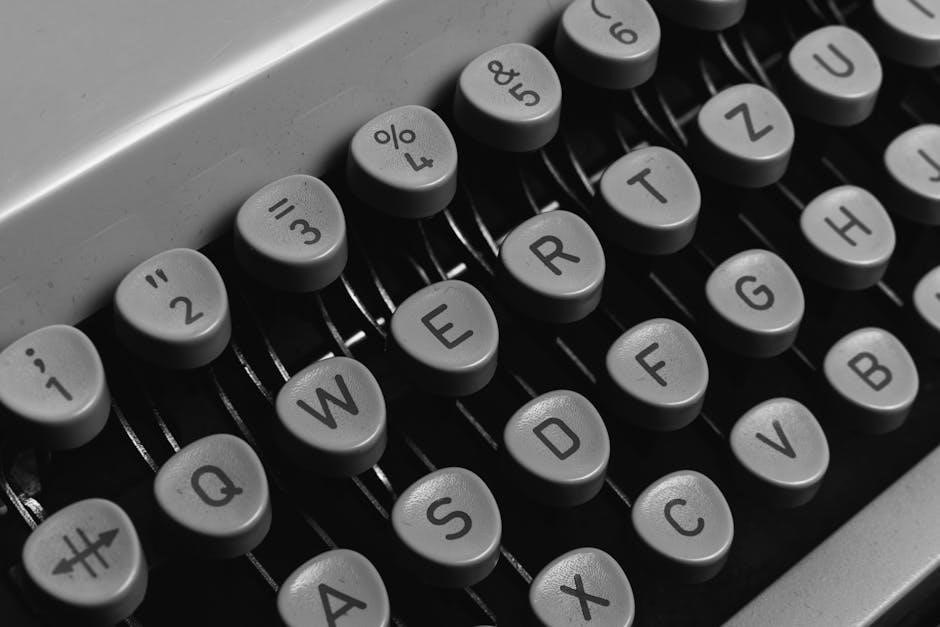
In case of an accident‚ stop the machine immediately and disconnect power. Provide first aid if needed and call emergency services. Evacuate the area if there’s a risk of further harm. Report incidents to supervisors and conduct a safety review. Keep a fire extinguisher nearby and ensure all exits are clear. Regular training on emergency procedures is crucial for quick‚ effective responses. Always stay calm and follow established protocols to ensure safety and minimize damage during emergencies involving a manual machine press.
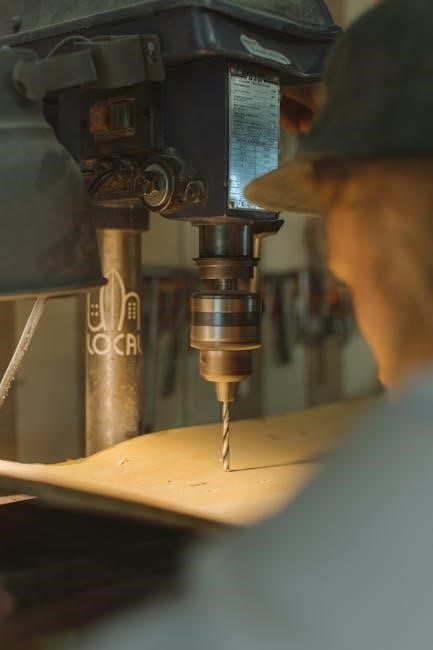
Selecting the Right Manual Machine Press
Selecting the right manual machine press involves assessing your specific needs‚ comparing features‚ and considering tonnage‚ precision‚ and budget constraints to ensure optimal performance and long-term efficiency.
Understanding Your Specific Needs
Understanding your specific needs is crucial when selecting a manual machine press. Assess the types of materials you work with‚ the required force‚ and the frequency of use. Consider the workspace and operator skill level. Define the desired precision and accuracy levels to ensure the press meets your production requirements. Additionally‚ evaluate the compatibility of the press with existing tooling and dies. This analysis ensures optimal performance and long-term efficiency for your operations. Proper planning prevents future challenges and enhances productivity.
Capacity and Tonnage Requirements
Capacity and tonnage requirements are critical when selecting a manual machine press. Capacity refers to the maximum force the press can apply‚ while tonnage indicates the material thickness it can handle. Assessing these ensures the press suits your material types and operations. Exceeding capacity risks machine damage and unsafe conditions. Always consult the manufacturer’s guidelines to match the press specifications with your workload for optimal performance and longevity;
Precision and Accuracy Factors
Precision and accuracy are vital for manual machine presses to ensure consistent results. The press’s frame stability‚ guide systems‚ and alignment features play a key role in maintaining precision. High-quality tooling and dies also contribute to accuracy. Proper setup and calibration are essential to achieve desired outcomes. Regular maintenance ensures optimal performance‚ while operator skill enhances precision. Selecting the right press for specific tasks guarantees accuracy and repeatability‚ making it a reliable choice for precise operations.
Budget and Cost Considerations
Budget and cost considerations are crucial when selecting a manual machine press. Initial purchase costs vary based on press capacity‚ features‚ and brand. Maintenance and operational expenses should also be factored in. Higher precision models may be more expensive upfront but offer long-term savings through reduced material waste. Comparing prices from different manufacturers and evaluating warranty options can help optimize your budget. Additionally‚ consider the cost of tooling and accessories‚ as they can significantly impact the total investment. Balancing quality‚ functionality‚ and affordability is key to making a cost-effective decision.
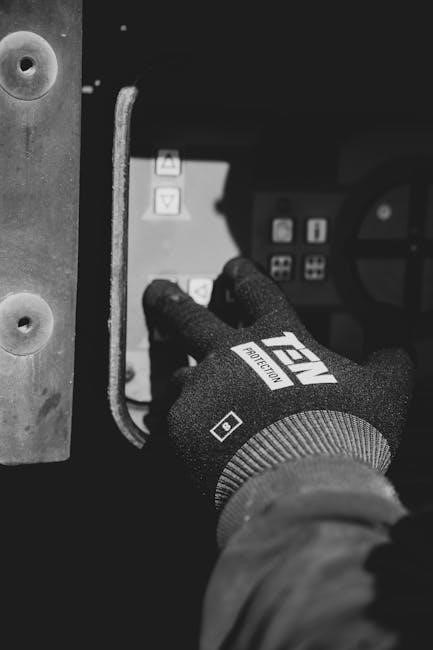
Manual vs. Powered Machine Presses
Manual presses rely on human effort for operation‚ offering simplicity and cost-effectiveness for small-scale tasks. Powered presses use automation for higher efficiency and scalability in production.
Comparison of Manual and Automated Presses
Manual machine presses operate via human effort‚ offering simplicity and cost-effectiveness for small-scale tasks. Automated presses‚ however‚ use advanced technology for faster‚ high-volume production. While manual presses are portable and require minimal setup‚ automated presses provide consistent results and reduce operator fatigue. Manual presses are ideal for low-capacity needs‚ whereas automated presses excel in large-scale industrial applications. Both options offer unique advantages‚ with manual presses emphasizing affordability and automated presses focusing on efficiency and scalability.
When to Choose a Manual Press
A manual press is ideal for small-scale production‚ precise control‚ and cost-sensitive applications. It is best suited for low-volume tasks‚ prototyping‚ or when exact force application is critical. Manual presses are also preferred in situations requiring simplicity and minimal setup‚ such as in educational settings or small workshops. They are cost-effective for businesses with limited budgets or those processing thin metals‚ plastics‚ or composites. Additionally‚ manual presses are perfect for operations where automation is unnecessary‚ ensuring ease of use and reduced maintenance needs.
Limitations of Manual Presses
Manual presses have limitations in scalability and efficiency for large-scale production; They require physical effort‚ reducing output speed and consistency over time. Limited tonnage capacity makes them unsuitable for heavy-duty applications. Repetitive tasks can lead to operator fatigue and potential errors. Additionally‚ manual presses lack automation features‚ making them less efficient compared to powered alternatives. They are best suited for small batches or precise tasks but may not meet demands for high-volume or complex operations requiring advanced control systems.
Future Trends in Manual Machine Press Technology
Future trends in manual machine press technology include integration with smart systems‚ IoT connectivity‚ and advanced materials. Hybrid systems combining manual and automated features are emerging. Energy-efficient designs and ergonomic improvements are expected‚ enhancing user experience. AI-driven diagnostics and predictive maintenance will optimize performance. Lightweight yet durable materials like advanced composites will dominate construction. These innovations aim to boost productivity while maintaining the precision and reliability manual presses are known for‚ ensuring their relevance in evolving industries.
